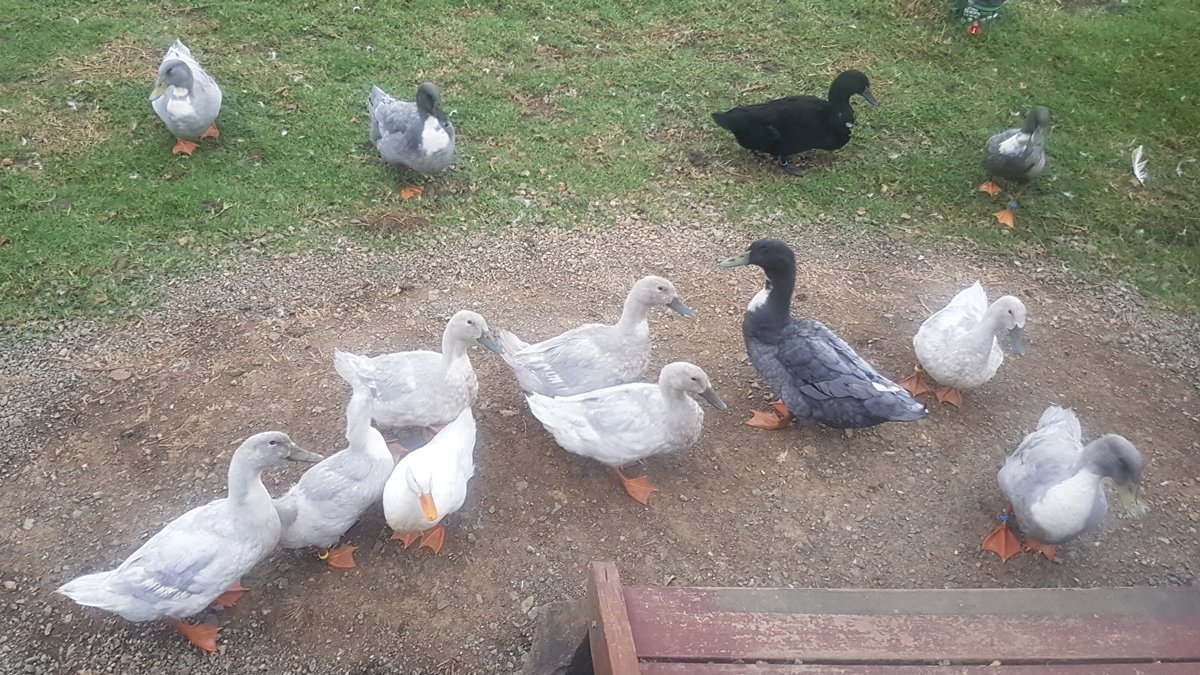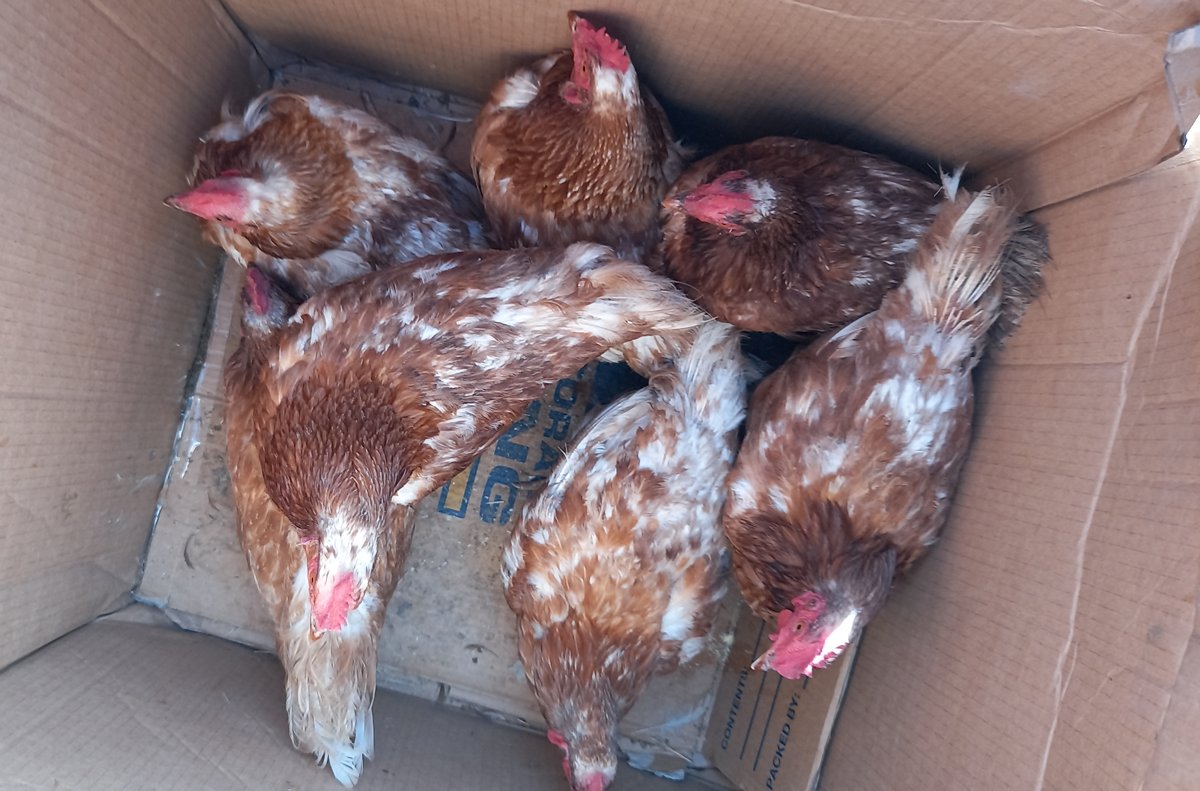We’ve kept chickens for around 5 years now. We got our first 4 Hyline chickens as pullets in mid-2017 – one of whom is still alive today, still laying the biggest eggs.
Some time in 2018, we picked up a random Brown Shaver for $10 at the Waipu Hammer Hardware, bringing us to the 5 chooks we had when we moved to The Outpost in 2019.

Our first flock of chickens arriving at The Outpost in September 2019.
By August 2020, we had lost a couple of chickens and needed to add some more, so we picked up another 3 Hyline pullets (a chicken that isn’t old enough to lay yet) from a local seller.
In April 2021, a customer at work ended up giving me 7 random pullets. 4 of them were roosters. They were going so well, and then last summer we faced some issues with a hawk. Now we are now down to one rooster and one chicken from that batch.
And so, going into no-egg season we had 4 chickens – including one who is 5 years old, and one who lays a very limited amount – plus the rooster. And the ducks.
Duck vs chicken
Up until yesterday, the chooks lived together with a flock of Swedish Blue ducks.
The ducks have been a conundrum for a while. They came with the property. But they’re susceptible to predation. They are loud, messy, and they eat a lot. They foul other animal’s drinking water; and while they are excellent at breeding, they are terrible parents and cannot raise a clutch of young without intervention.

In terms of their ‘use’ – their eggs are frequently laid in the mud or gorse, and only from August to December. We didn’t really love eating them so had limited uses for them anyway.
We tried processing the ducks for meat and while I’m glad I’ve experienced that process, I wasn’t a fan. Plucking their thick, waterproof feathers is particularly difficult. It’s not worth the effort and expense of raising them.

If a duck can swim, the duck will swim. And shit. Keeping the drinking water clean was always a struggle.
Then, when we tried to go the permaculture route and let them live in the orchard to eat the slugs and snails there; they become hawk food. I would go down to feed them and see a big puff of feathers somewhere in the paddock. When I got closer, I’d find a perfectly-picked carcass. It was quite devastating to find my favourite duck had lost her life that way.
We frequently received comments about how cool and different they are. And they are cool, but we don’t have a pond. We cannot keep them in the orchard because of the hawk. And the dogs mean they can’t really free-range. It’s a limited life for them and we didn’t feel great about it.
Decisions…
We quietly decided last year that we would stop intervening in their breeding and simply let them live out their ducky lives. By our plan, we presumed they would eventually go extinct here – or learn to stop killing their babies. Either way, we planned to feed them and look after them, but ultimately let nature do its thing.
Then we got an offer from someone with ponds (plural!), land, and the resources to take care of them. Someone who can give them a better place to live, and support them to breed. Technically they’re a rare breed so it would be a shame to just let them die. We agreed. It was the best decision for everyone.
Yesterday we rounded the nine remaining ducks up and sent them off to their new home. They’ll be waking up there as I publish this blog.
The newest girls
In the meantime, we decided to go max-chicken.
We decided we’d pick up some ex-pasture farm chickens. Once a chicken gets a bit older, her egg production drops off from one every day to one most days. This is enough to make her uneconomical for an egg farmer to feed, so they’re sold off (or culled) when they hit 18 months old.
But we have a 5 year old chook still laying excellent eggs on a fairly regular basis. 18 months is still young! There were plenty of ‘ex-layers’ available when we looked; they were cheaper than a younger chicken; and they wouldn’t require any special food to start them off. They might even lay right away!
The limiting factor on how many chickens we can have is the chicken coop. With 4 hens and 1 rooster already in residence, we had room for seven chickens if we wanted to go max chicken.
They turned up two weeks ago. All seven of them. Max chicken. #chickenfarm.

There were three eggs in the box with them – an auspicious start given they were all in the middle of a moult!
Settling in
They’ve mostly kept to themselves, but there have definitely been some extra squawks and squabbles lately as the new pecking order is established.

They’re a little smaller than our other girls, and definitely in rattier condition. Their first moult is really hitting them. To help them through it, we’re feeding out extra protein in the form of dog roll and a brand of tinned cat food our cats do not eat, but which was nevertheless purchased in February 2020 ‘just in case’.
A couple of the new girls have learned early why the fence exists. It’s less about keeping the chickens out of anything – I’d let them free-range if we could – and more about keeping the dogs off the poultry.

We haven’t had any incidents of dogs mouthing chickens in a while, but they’re certainly happy to give chase if a bird is found to be out ‘out-of-bounds’. Thankfully, there have been no further excursions since the first two learned that lesson.
Overflowing with eggs?
We’re lucky to get one egg a day right now. We haven’t found any hidden nests, so I’ve got to assume it’s just the time of year. Luckily I had a good moan about that last year and a reader reminded me to store eggs over summer – which I actually did! We should be able to avoid buying eggs this winter.
However, once we get to spring, we could be looking at 11 eggs a day. Too many for just the two of us. We’re lucky to have a neighbour who exchanges her home-baked sourdough for a box of fresh eggs.
It’s a fantastic arrangement – I will forever think I’m getting the better side of the deal, and I suspect she thinks the same thing. And we both get the freshest eggs on the freshest sourdough from the comfort and safety of our own kitchens, whenever we want.
We’ve never been able to completely meet her demand before – we definitely will come spring! The dogs will be happy getting a daily egg again as well.
Life evolves
We tried the ducks – for close to three years. They weren’t part of my original plan, but we tried because they came with the land. It didn’t work for us.
I’m not saying no more ducks. I quite liked them and I’m glad the door is open to bring decedents of the original flock ‘home’ sometime. But I want to be better-prepared to meet their needs if we ever try again.
We’ve always loved the chooks though – they were always on the plan. When this place was still a very distant dream, my friends and I referred to the whole idea as #chickenfarm. Without the ducks, the work associated with our poultry should become a lot easier too.
Increasing our egg supply and renewing our flock means we should be set for the future – as long as we can give them enough cover to keep that hawk off.
After we had safely shut the ducks in the car, I looked back at my slightly-confused chicken flock and I knew this was the right decision. We all win.
A post-publishing update: check out this link to see the ducks being released in their new home. They look absolutely thrilled, and Richard and I are very happy to see them so happy.


